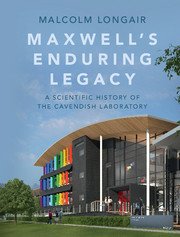Book contents
- Frontmatter
- Dedication
- Contents
- Preface
- Acknowledgements
- Part I To 1874
- 1 Physics in the nineteenth century
- 2 Mathematics and physics in Cambridge in the nineteenth century
- Part II 1874 to 1879
- Part III 1879 to 1884
- Part IV 1884 to 1919
- Part V 1919 to 1937
- Part VI 1938 to 1953
- Part VII 1953 to 1971
- Part VIII 1971 to 1982
- Part IX 1984 to 1995
- Part X 1995 to present
- Appendix The evolution of the New Museums site
- Notes
- References
- Author index
- Subject index
1 - Physics in the nineteenth century
from Part I - To 1874
Published online by Cambridge University Press: 05 July 2016
- Frontmatter
- Dedication
- Contents
- Preface
- Acknowledgements
- Part I To 1874
- 1 Physics in the nineteenth century
- 2 Mathematics and physics in Cambridge in the nineteenth century
- Part II 1874 to 1879
- Part III 1879 to 1884
- Part IV 1884 to 1919
- Part V 1919 to 1937
- Part VI 1938 to 1953
- Part VII 1953 to 1971
- Part VIII 1971 to 1982
- Part IX 1984 to 1995
- Part X 1995 to present
- Appendix The evolution of the New Museums site
- Notes
- References
- Author index
- Subject index
Summary
Where better to start than with the definition of physics from the Oxford English Dictionary: The Definitive Record of the English Language:
physics, n. The branch of science concerned with the nature and properties of non-living matter and energy, in so far as they are not dealt with by chemistry or biology; the science whose subject matter includes mechanics, heat, light and other radiation, sound, electricity, magnetism, gravity, the structure of atoms, the nature of subatomic particles, and the fundamental laws of the material universe.
Most twenty-first-century physicists would find this definition sufficiently allencompassing to describe what physics is about.Many, including the present author, would argue that the extensive nature of the subject and its emphasis upon model-building and problem-solving enables it to embrace a vastly wider range of cognate fields, including chemistry, biology, medicine and economics. But the mid-nineteenth-century scientist, and in particular one associated with Cambridge University, would have formed a very different view.
Discoveries in physics, 1687 to 1874
It is enlightening to study a time-line of major discoveries and advances in what we would now call physics, as well as selected topics from cognate disciplines such as chemistry, mathematics and particularly technology. The items in Table 1.1 span the period from the date of publication of Isaac Newton's Philosophiæ Naturalis Principia Mathematica (Newton, 1687) to the opening of the Cavendish Laboratory in 1874. The contents of the table are necessarily subjective but provide a broad-brush picture of the standard history of physics. The country and location where the advances were made, as well as those which originated in Cambridge, are also indicated.
There are a number of striking features of Table 1.1. There is no question about the overwhelming impact of Newton's laws of motion and of gravity of 1687. Newton and his followers promoted vigorously the corpus of Newton's great works in the sciences of mechanics, statics, dynamics, gravity and optics. Nowhere was this more assiduously practiced than in his alma mater, Cambridge University, where, well into the nineteenth century, Newton's approach to the laws of motion were taught to the exclusion of the more powerful mathematical methods of analysis which had been developed in continental Europe.
- Type
- Chapter
- Information
- Maxwell's Enduring LegacyA Scientific History of the Cavendish Laboratory, pp. 3 - 34Publisher: Cambridge University PressPrint publication year: 2016



